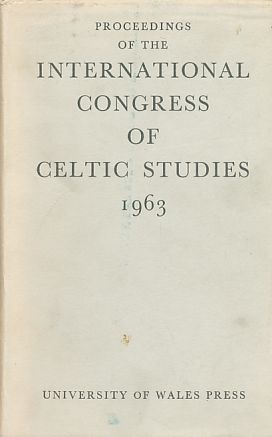lewis henry thomas jones lloyd (1 resultados)
Tipo de artículo
- Todo tipo de artículos
- Libros (1)
- Revistas y publicaciones
- Cómics
- Partituras
- Arte, grabados y pósters
- Fotografías
- Mapas
-
Manuscritos y
coleccionismo de papel
Condición
- Todo
- Nuevos
- Antiguos o usados
Encuadernación
- Todo
- Tapa dura
- Tapa blanda
Más atributos
- Primera edición
- Firmado
- Sobrecubierta
- Con imágenes del vendedor
- Sin impresión bajo demanda
Ubicación del vendedor
Valoración de los vendedores
-
Proceedings of the Second International Congress of Celtic Studies. Held in Cardiff 6-13 July, 1963.
Publicado por Cardiff: University of Wales Press, 1966
Librería: Fundus-Online GbR Borkert Schwarz Zerfaß, Berlin, Alemania
Libro
Condición: Sehr gut. XIX; 136 S.; Abb.; Kt. Umschl. leicht berieben. - Aus dem Nachlass von Michael Richter. Mit Namensstempel auf Vorsatz. - Preface -- Members of the Congress -- List of papers read at the Sectional Sessions -- Papers read at the Plenary Sessions: -- Ralegh Radford, Cultural Relationships of the -- Celtic World -- Alwyn D Rees, Modern Evaluations of Celtic -- Narrative Tradition -- J E Caerwyn Williams, Medieval Welsh Religious -- Prose -- Joshua Whatmough, Continental Celtic -- David Greene, The making of Insular Celtic. // If the story of mankind is viewed in the classic manner as a journey from Savagery, through Barbarism, to Civilization, the second transition from Barbarism to Civilization is one of the formative stages in the evolution of the peoples that we know today. The importance of this stage has recently been stressed by the appearance of a lavishly illustrated volume entitled the Dawn of Civilization, which traces the evolution of races in various parts of the world up to this stage. Not unnaturally a picture drawn on so vast a scale can devote little space to those peoples who came late into the light of civilization. It is proposed in this lecture to examine rather more closely this transition as it affected the Celtic peoples. Barbarism, the stage of self-sufficient food production, was the normal condition of western Europe during the Bronze Age. Civilization, implying a more complex social and economic organization, gradually pervades the Celtic world in the last centuries before and after the beginning of the present era. The Celtic world must first be defined. The use of the adjective implies that we are concerned with the geographical region inhabited by peoples who spoke one of the Celtic languages. This sets an upward limit to the thesis. Earlier than c. 500 B.C. there are no sure criteria by which peoples of Celtic speech can be identified; after that date identifications become increasingly clear. One point should be added: a Celtic people, as it is here proposed to use the term, may be an amalgam, only one element of which spoke a Celtic language. (S. 3 / THE CULTURAL RELATIONS OF THE EARLY CELTIC WORLD by RALEGH RADFORD) Sprache: Englisch Gewicht in Gramm: 550 Originalleinen mit Schutzumschlag.


